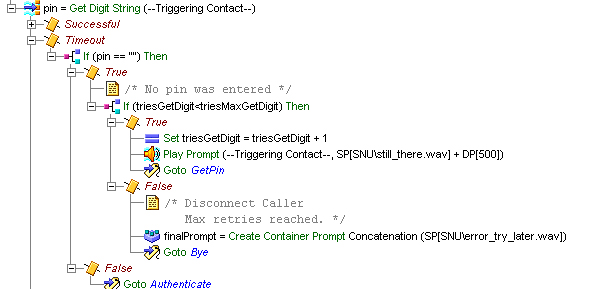The Timeout Output Branch
If the Get Digit String step reaches the timeout limit before receiving input from the caller, the script executes the Timeout output branch.
Configure the Timeout output branch of the Get Digit String step to give the caller further chances to enter a valid PIN number, until the script reaches the maximum number of retries, after which the Unsuccessful output branch executes.
Figure shows the scripting under the Timeout output branch of the Get Digit String step.

Use the first If step to evaluate the expression pin==“ ”.
Note | For details on configuring the If step, see the If Step section. |
If the expression is true, and the pin variable is empty, this means that the Get Digit String step has timed out without the caller having entered PIN information. In this case, the True output branch under this If step executes.
If the expression is false, the pin variable does contain PIN information, which means that the caller has already entered PIN information.
In this case, the False output branch executes, and a Goto step sends the script to the Label step named Authenticate, which is located directly above the Authenticate User step, as shown in.
Tip | Using the If step in this way is a trick that you can use to allow the caller to enter the PIN without a terminating key and wait for the timeout to let the system deal with the digits collected so far. This trick works well only if the maximum number of retries is set to 0, as it is in this example. |
Use the first If step under the Timeout output branch of the Get Digit String step to determine whether or not PIN information exists.
If no PIN information exists, then the True output branch executes, and you then use a second If step to determine whether or not the script has reached the maximum number of retries in the attempt to obtain PIN input information from the caller.